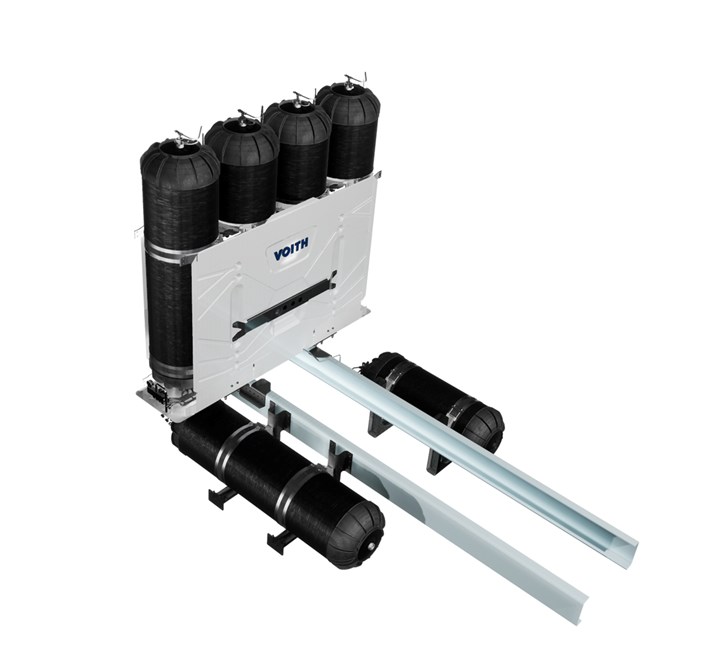Voith H2 storage tanks made with in-house towpreg winding
Plug & Drive H2 storage system displayed at IAA Transportation 2022 uses 700-bar tanks for heavy-duty commercial and construction vehicles.
Voith Composites (Heidenheim, Germany) is further expanding its expertise in the e-mobility sector to promote an economical and sustainable mobility shift for heavy-duty trucks and buses. Two concepts to be presented at IAA Transportation 2022 is the Voith Electrical Drive System (VEDS) and the Plug & Drive H2 storage system. For the latter, Voith applies in-house towpreg winding for tank manufacture that reportedly enables optimized winding layers, leading to an increase in the amount of H2 that can be stored without compromising safety or tank pressure.
“Alternative, sustainable drives are defining the discourse of the present and the technologies of the future,” Martin Wawra, EVP and CEO, Voith Turbo Mobility, says. “Even today, the result is an unprecedented variety of drive solutions. We are fulfilling these customer demands with a portfolio geared towards alternative drives.”
The Plug & Drive H2 storage system provides customers everything from a single source, Voith points out, from the tank nozzle to the fuel cell inlet, including a patented installation system to accommodate the H2 tanks. At 700-bar, the hydrogen tanks are said to ensure long ranges even with limited installation spaces, in addition to short refueling times — it takes about 10 minutes for full refueling. The system is primarily designed for heavy-duty commercial vehicles, construction vehicles and similar applications, where the use of battery-electric concepts does not make sense from an economical or technical perspective. Voith also ensures sustainability and recyclability throughout the entire lifecycle.
Voith’s portfolio also now consists of a heavy-duty (HD) VEDS variant (which is well suited for double-decker and articulated buses with its 340-kilowatt IPMS motor), and a medium-duty (MD) VEDS variant with an output of 260 kilowatts, which is optimized specifically for solo buses and inner-city use. The MD VEDS offers customers an efficiency level of 0.69 kilowatt-hours per kilometer. The Wrightbus StreetDeck Electroliner is one example of a highly efficient e-double-decker bus where VEDS plays a significant role.
The concept supports battery systems from a wide range of manufacturers and is also enabled for use in fuel cell electric vehicle (FCEV) drivetrains, according to the company. Its compact design means that VEDS doesn’t requires additional installation space in chassis designed for combustion engines, making it easier to convert existing vehicle fleets with conventional diesel, hybrid or gas drives.
With the VEDS HD+, the company is also introducing its first drive concept for heavy-duty trucks. Special configurations for waste collection vehicles, inner-city logistics or long-distance transport applications ensure efficient driving. The core of the system is a new automated four-gear electric transmission, which Voith contends makes optimal traction available for every driving situation and under any load condition. At the same time, it ensures that the electric motor is always operated at optimum efficiency.
The VEDS HD, VEDS MD and VEDS HD+ meet ISO 26262 (Automotive Functional Safety) requirements and the new requirements for ISO 21434 (Automotive Cyber Security). This internationally applicable standard protects the vehicle against external manipulations and ensures its functionality — by preventing unauthorized access to electronically controlled driving and braking systems, for example.
Related Content
-
Hexagon Purus opens new U.S. facility to manufacture composite hydrogen tanks
CW attends the opening of Westminster, Maryland, site and shares the company’s history, vision and leading role in H2 storage systems.
-
Composites end markets: Automotive (2024)
Recent trends in automotive composites include new materials and developments for battery electric vehicles, hydrogen fuel cell technologies, and recycled and bio-based materials.
-
Composite sidewall cover expands options for fire-safe rail components
R&D project by CG Rail explores use of carbon fiber-reinforced thermoplastics and recycled manufacturing scrap to meet fire safety, weight and volume targets.
















